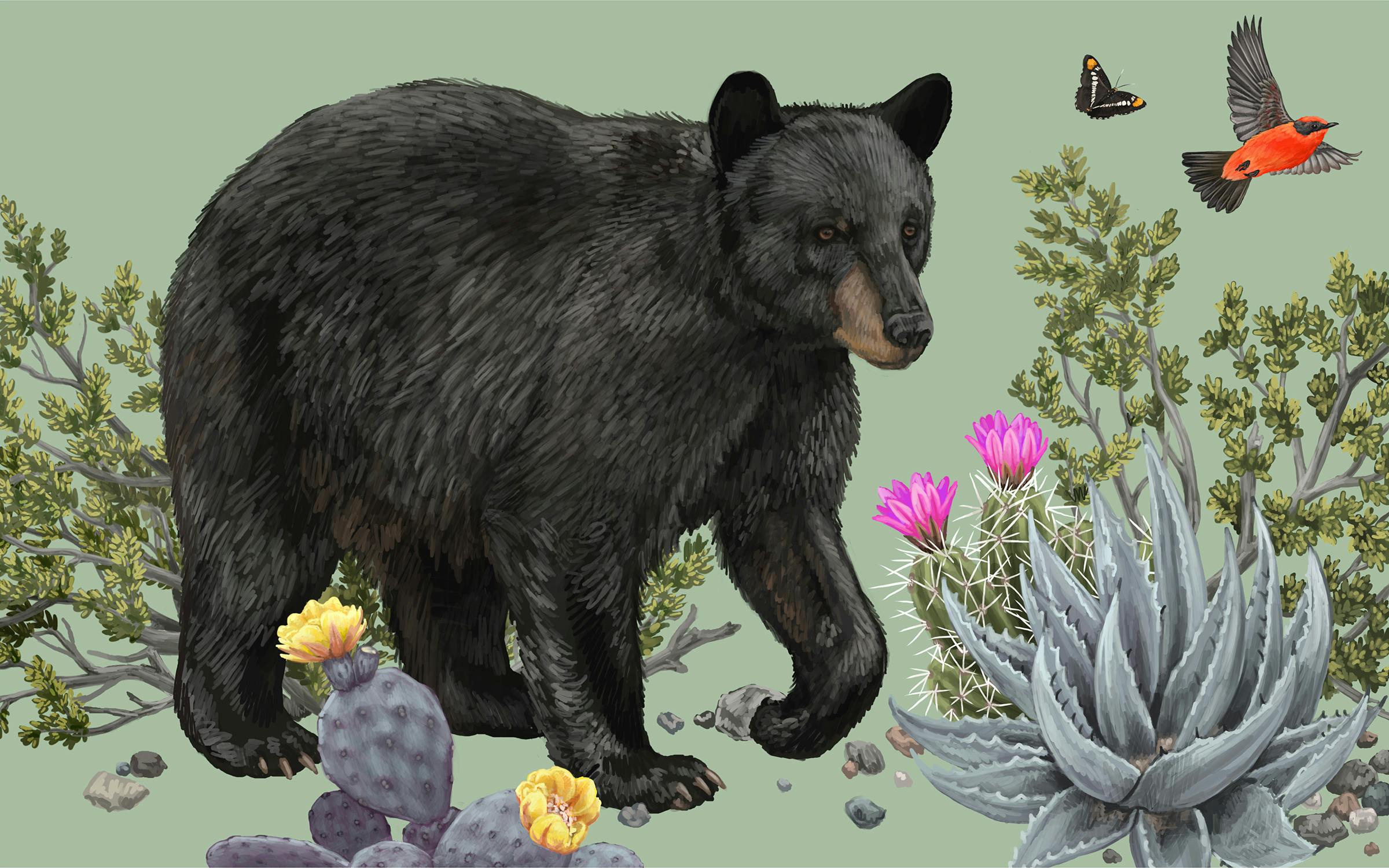Latin name: Ursus americanus
Size: 125 to 500 pounds (adult males)
Texas habitat: West and southwest
Celebrating the end of our hike up the South Rim Trail, in Big Bend National Park, my friends and I tucked into steaming bowls of jambalaya before making camp. Dinner smelled wonderful—and we weren’t the only ones who thought so. A black bear popped its head up over the canyon rim, about forty feet away, sniffing with its velvety snout while ambling toward us. I felt both awe and terror before our uninvited guest lumbered off. Encounters like mine are increasing in West Texas, where black bears are making a comeback.
How many live here?
Likely “north of a hundred,” says Louis Harveson, director of the Borderlands Research Institute at Alpine’s Sul Ross State University. Thousands of black bears moseyed across Texas until the 1950s, when they vanished from the state, victims of overhunting and habitat destruction. Their return began in the late 1980s, and now bears thrive in a growing swath of southwest and West Texas. Just before we spoke, Harveson received a photo taken near Del Rio, about 215 miles east of Big Bend, of a mama and two cubs. “There’s probably more bears out there than we realize,” he says. “Texas better get ready.”
What does he mean?
We need to keep food and garbage out of reach of these “three-hundred-pound raccoons,” as Harveson fondly calls them. They love to dumpster dive, but the habit can make them aggressive, and wildlife officials commonly euthanize such bears in other states.
Have any Texas bears been put down for aggression?
No, though less serious incidents often occur, says Krysta Demere, a wildlife diversity biologist with Texas Parks and Wildlife in Fort Davis. “We’ve had pet food stolen, sandals taken off porches, and an unfortunate incident with a golf cart.” (A bear ate the leather seat.) Bird and deer feeders are catnip for bears, so Demere helps folks make changes, such as electrifying feeders to deliver a harmless zap or adding “unwelcome mats” with painful but noninjurious nails. “We’re still in the early stages of learning what it means to have bears back in their native range,” she says, “but Texans are excited to have them back.”
What are their reproductive habits like?
Evolutionary geniuses, black bears have a trait called delayed implantation, in which fertilized embryos can pause their development for months, floating around the uterus until the time is right to grow into a baby bear. Black bears typically mate in June or July, but the embryo doesn’t implant until November or December—after the mama-to-be has gorged herself on food to survive her winter denning (technically torpor, which is a lighter sleep than full-on hibernation). “In the fall, they’re eating voraciously,” says Dana Karelus, TPWD’s state mammal specialist. This is the season of Fat Bear Week. “Then once the female is fit enough and finds a good place to den, the embryo will implant.” Otherwise, no harm done: her body can simply shed the embryo without devoting resources to a cub that won’t survive. About a hundred other mammals, including some skunks and bats, have the same mind-boggling trait.
Anything else I should know?
To get better estimates of how many bears are in which parts of Texas, Harveson and his fellow scientists are studying the critters with an ingenious tool called a hair snare. Rather than trapping the bears themselves (which can be quite an undertaking, given their size and the need for sedation), a hair snare merely snags a few strands of fur, usually on barbed wire after an animal is lured in by a tasty treat. Then the researchers can analyze the DNA and identify each individual back in the lab. Hair snares are used in bear studies nationwide, but the harsh Texas landscape adds a challenging layer. “Everybody else across the country has trees to work with, and we don’t,” says Karelus, noting that the barbed wire for the snare is often strung between branches. “So we’re still working out the design.”
One more thing: black bears aren’t always black. “They can be a lot of different shades,” Karelus says, including all flavors of brown, blue-gray, and even white. That last category is quite rare; they’re also called spirit bears or kermode bears and are found only in British Columbia. In Texas, though, black bears tend to live up to their name. “Our bears are typically black,” Karelus says. “It seems to be more in the West that they can be brown.”
An abbreviated version of this article originally appeared in the September 2024 issue of Texas Monthly with the headline “Black Bear.” Subscribe today.

